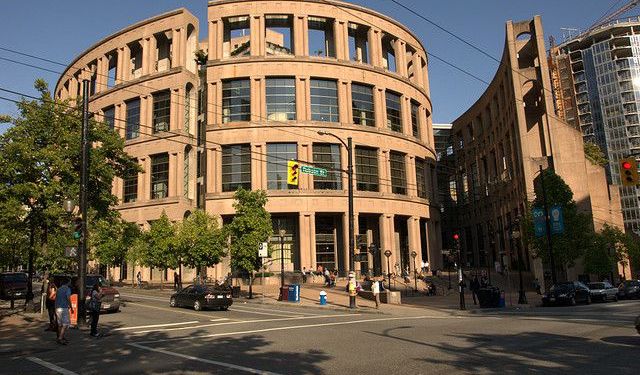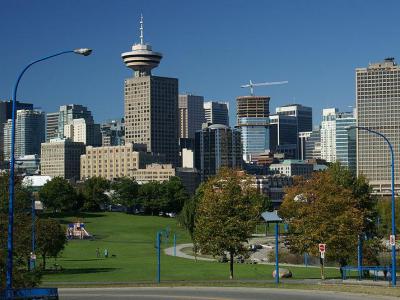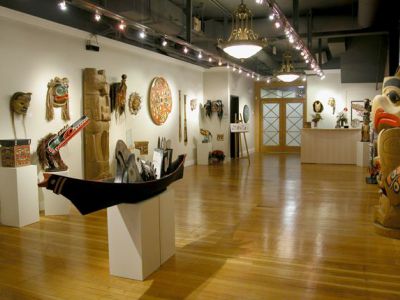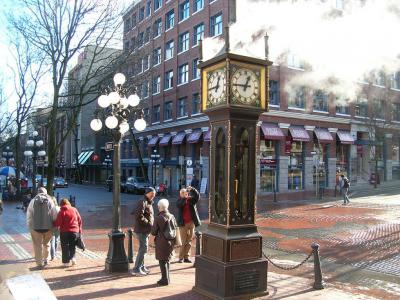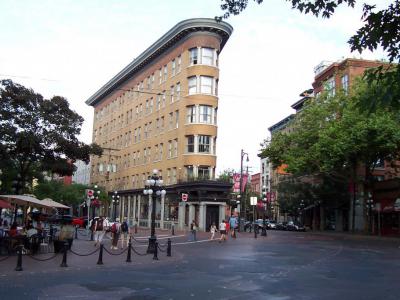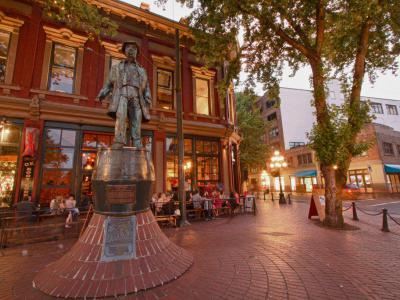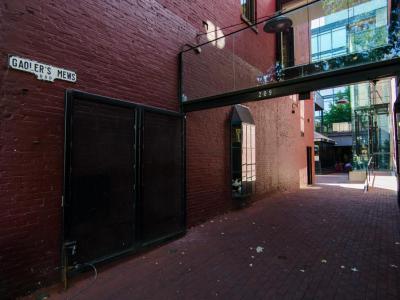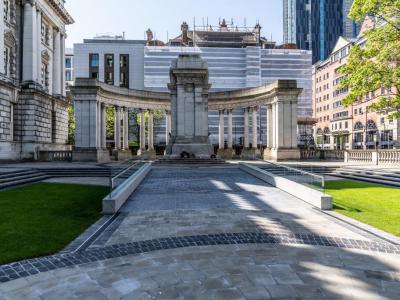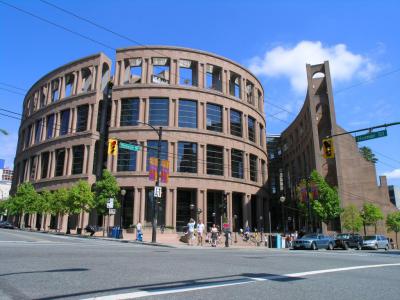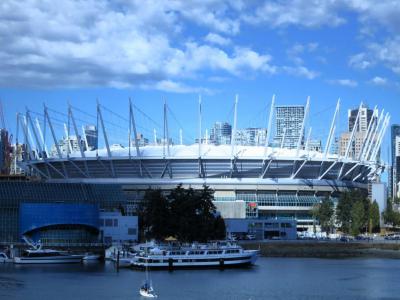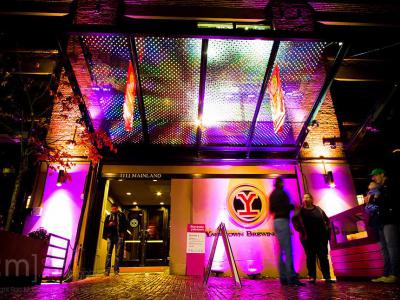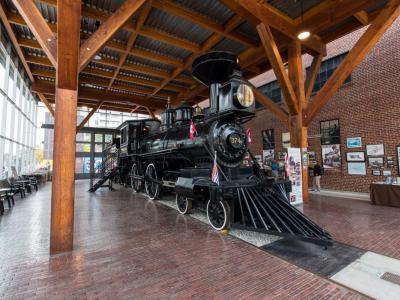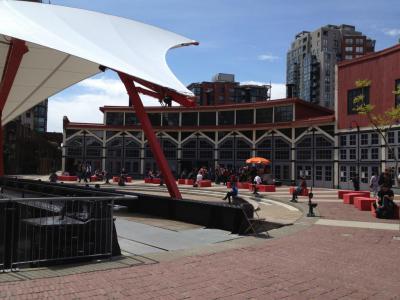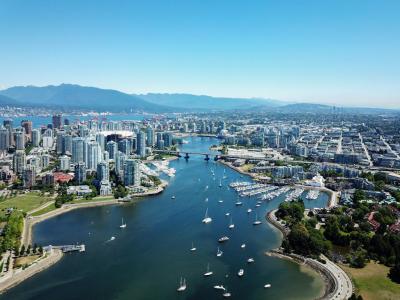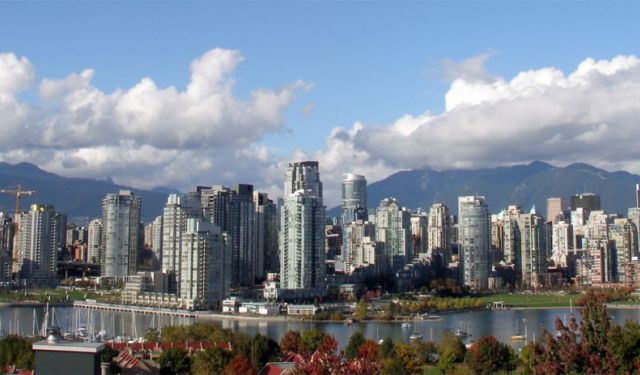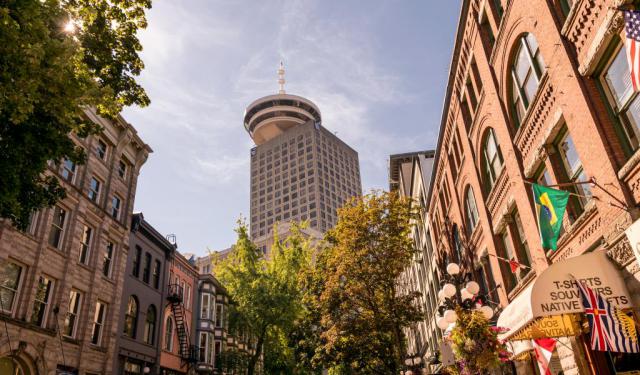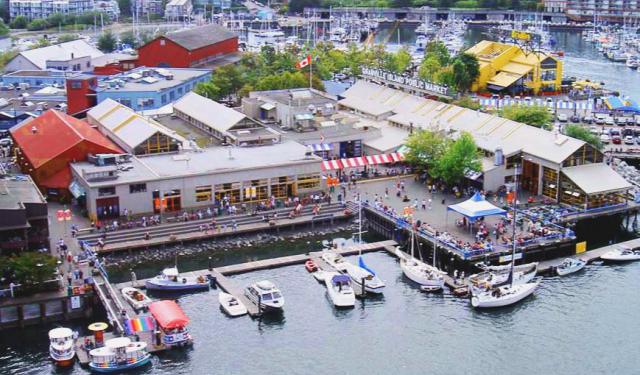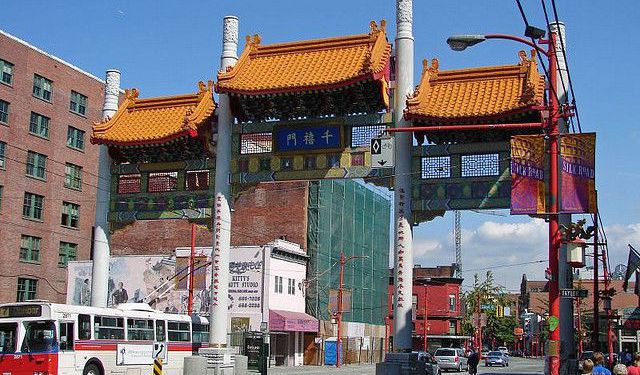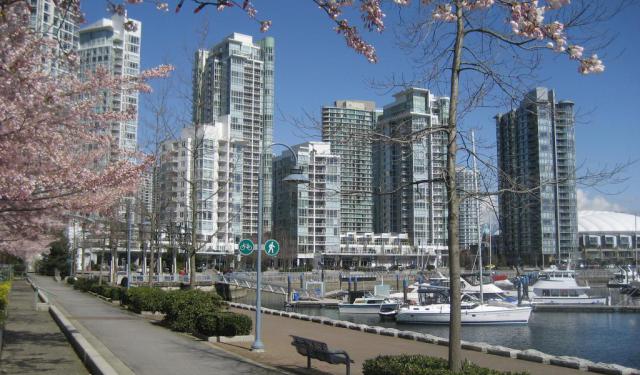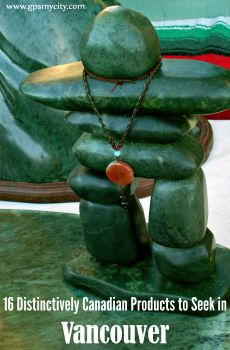Vancouver Downtown Walking Tour (Self Guided), Vancouver
Numerous historic and otherwise notable landmarks scattered throughout Downtown Vancouver make it a hot traveler's destination. Each such landmark is unique in itself and has a great deal of story to tell visitors, be it cultural history or simple amusement.
While in Downtown you can't miss the Vancouver Lookout. This observation deck lures you with its breathtaking scenery – the bird's-eye view of the city and surrounding mountains.
After that, you may want to check out the Coastal Peoples Fine Arts Gallery, showcasing indigenous arts and culture – a great opportunity to appreciate the heritage of Canada's First Nations. Right next to it, Gastown Steam Clock is another famous attraction, known for its hourly steam-powered whistle show.
This charming neighborhood also houses the Old Spaghetti Factory Restaurant, where you can enjoy a delicious meal in a historic setting.
The Hotel Europe, often referred to as the Flat Iron Building, is a distinctive architectural gem with a unique triangular shape. Nearby, Maple Tree Square and Deighton's Statue pay homage to the area's historical significance as the birthplace of Vancouver.
Exploring further, you'll discover Gaoler's Mews, Victory Square Cenotaph, and the Holy Rosary Cathedral, each offering a glimpse into the city's past and culture.
For those seeking knowledge and relaxation, the Vancouver Public Library is a modern and welcoming space, while sports enthusiasts can head to BC Place Stadium to catch a game or event.
Don't miss the chance to visit the Yaletown Brewing Company, where you can enjoy locally crafted beers and delicious food in a trendy atmosphere.
History buffs will appreciate the Canadian Pacific 374, a historic steam locomotive, and the Roundhouse Community Arts & Recreation Centre, which showcases the city's industrial heritage.
Finally, False Creek, with its scenic waterfront and recreational opportunities, provides a much-wanted tranquil escape.
As you can see, Downtown Vancouver is a bustling urban district with a mix of historical sites, cultural attractions, and modern amenities that cater to a variety of interests. So, join us on this self-guided tour and experience the best that this dynamic neighborhood has to offer!
While in Downtown you can't miss the Vancouver Lookout. This observation deck lures you with its breathtaking scenery – the bird's-eye view of the city and surrounding mountains.
After that, you may want to check out the Coastal Peoples Fine Arts Gallery, showcasing indigenous arts and culture – a great opportunity to appreciate the heritage of Canada's First Nations. Right next to it, Gastown Steam Clock is another famous attraction, known for its hourly steam-powered whistle show.
This charming neighborhood also houses the Old Spaghetti Factory Restaurant, where you can enjoy a delicious meal in a historic setting.
The Hotel Europe, often referred to as the Flat Iron Building, is a distinctive architectural gem with a unique triangular shape. Nearby, Maple Tree Square and Deighton's Statue pay homage to the area's historical significance as the birthplace of Vancouver.
Exploring further, you'll discover Gaoler's Mews, Victory Square Cenotaph, and the Holy Rosary Cathedral, each offering a glimpse into the city's past and culture.
For those seeking knowledge and relaxation, the Vancouver Public Library is a modern and welcoming space, while sports enthusiasts can head to BC Place Stadium to catch a game or event.
Don't miss the chance to visit the Yaletown Brewing Company, where you can enjoy locally crafted beers and delicious food in a trendy atmosphere.
History buffs will appreciate the Canadian Pacific 374, a historic steam locomotive, and the Roundhouse Community Arts & Recreation Centre, which showcases the city's industrial heritage.
Finally, False Creek, with its scenic waterfront and recreational opportunities, provides a much-wanted tranquil escape.
As you can see, Downtown Vancouver is a bustling urban district with a mix of historical sites, cultural attractions, and modern amenities that cater to a variety of interests. So, join us on this self-guided tour and experience the best that this dynamic neighborhood has to offer!
How it works: Download the app "GPSmyCity: Walks in 1K+ Cities" from Apple App Store or Google Play Store to your mobile phone or tablet. The app turns your mobile device into a personal tour guide and its built-in GPS navigation functions guide you from one tour stop to next. The app works offline, so no data plan is needed when traveling abroad.
Vancouver Downtown Walking Tour Map
Guide Name: Vancouver Downtown Walking Tour
Guide Location: Canada » Vancouver (See other walking tours in Vancouver)
Guide Type: Self-guided Walking Tour (Sightseeing)
# of Attractions: 15
Tour Duration: 2 Hour(s)
Travel Distance: 3.7 Km or 2.3 Miles
Author: DanaOffice
Sight(s) Featured in This Guide:
Guide Location: Canada » Vancouver (See other walking tours in Vancouver)
Guide Type: Self-guided Walking Tour (Sightseeing)
# of Attractions: 15
Tour Duration: 2 Hour(s)
Travel Distance: 3.7 Km or 2.3 Miles
Author: DanaOffice
Sight(s) Featured in This Guide:
- Vancouver Lookout
- Coastal Peoples Fine Arts Gallery
- Gastown Steam Clock
- Old Spaghetti Factory Restaurant
- Hotel Europe (Flat Iron Building)
- Maple Tree Square
- Gaoler's Mews
- Victory Square Cenotaph
- Holy Rosary Cathedral
- Vancouver Public Library
- BC Place Stadium
- Yaletown Brewing Company
- Canadian Pacific 374
- Roundhouse Community Arts & Recreation Centre
- False Creek
1) Vancouver Lookout (must see)
Situated atop the Harbour Centre in close proximity to the charming Gastown district, the Vancouver Lookout stands as a popular tourist destination, providing panoramic 360-degree vistas of the cityscape.
From this vantage point, approximately 550 feet (equivalent to 168 meters) in height, you are treated to an expansive bird's-eye scene that encompasses Canada Place and the entirety of Vancouver's bustling downtown nucleus. Additionally, your gaze can trace the contours of Stanley Park, the North Shore Mountains, Burrard Inlet, and, weather permitting, extend as far as Surrey and beyond.
The ascent to the pinnacle of the Vancouver Lookout forms an integral part of the overall experience. Notably, the elevator's front is entirely composed of glass, and a significant portion of the ascent occurs on the exterior of the edifice. This distinctive approach grants an unparalleled view of downtown Vancouver and the surroundings as you ascend to the observation deck.
The deck itself is circular in design, enveloping the structure seamlessly. Scattered across this expanse are various spots furnished with tables and chairs, offering ideal vantage points to revel in the spectacle. Furthermore, the observation deck is adorned with informative plaques that provide valuable insights into the multitude of sights within view.
Tip:
Tickets are valid all day, so you can go in the morning and then come back at sunset to see the city lit up at night.
You can spend as little or as long as you like, but make sure you walk the whole Lookout floor.
Also, check the weather forecast in advance, so there isn't any fog when you visit; otherwise, you won't see a thing!
From this vantage point, approximately 550 feet (equivalent to 168 meters) in height, you are treated to an expansive bird's-eye scene that encompasses Canada Place and the entirety of Vancouver's bustling downtown nucleus. Additionally, your gaze can trace the contours of Stanley Park, the North Shore Mountains, Burrard Inlet, and, weather permitting, extend as far as Surrey and beyond.
The ascent to the pinnacle of the Vancouver Lookout forms an integral part of the overall experience. Notably, the elevator's front is entirely composed of glass, and a significant portion of the ascent occurs on the exterior of the edifice. This distinctive approach grants an unparalleled view of downtown Vancouver and the surroundings as you ascend to the observation deck.
The deck itself is circular in design, enveloping the structure seamlessly. Scattered across this expanse are various spots furnished with tables and chairs, offering ideal vantage points to revel in the spectacle. Furthermore, the observation deck is adorned with informative plaques that provide valuable insights into the multitude of sights within view.
Tip:
Tickets are valid all day, so you can go in the morning and then come back at sunset to see the city lit up at night.
You can spend as little or as long as you like, but make sure you walk the whole Lookout floor.
Also, check the weather forecast in advance, so there isn't any fog when you visit; otherwise, you won't see a thing!
2) Coastal Peoples Fine Arts Gallery
Coastal Peoples Gallery is a home to one of the largest commercial collections of Northwest Coast Native and Inuit Art. Founded in 1996, this gallery is focused on representing the unparalleled contemporary art of the First Nations, identifying the distinct styles and diverse artists who inhabit the Canadian Northwest coast and Arctic regions. As of 2017, Coastal Peoples has been ideally located in Gastown, by the waterfront, in a restored historic Le Magasin warehouse built in 1912.
Recognized for representing British Columbia’s master carvers, the gallery is reputed for discovering a new generation of gifted artists who push the boundaries of this legendary art form, and bringing together visitors and collectors anxious to experience their superb creations. The gallery's collections include gold and silver jewelry, glass-work, masks and sculptures.
Recognized for representing British Columbia’s master carvers, the gallery is reputed for discovering a new generation of gifted artists who push the boundaries of this legendary art form, and bringing together visitors and collectors anxious to experience their superb creations. The gallery's collections include gold and silver jewelry, glass-work, masks and sculptures.
3) Gastown Steam Clock
Among Gastown's many attractions, none holds as much renown as the Gastown Steam Clock. Although this clock isn't the oldest fixture in the neighborhood (and similar steam clocks can be found elsewhere), it stands as one of the rare functioning steam-powered clocks remaining worldwide.
Originally constructed above a steam grate, this endeavor served several purposes. It concealed the unappealing grate from view, harnessed the otherwise wasted steam power from the local heating system, and deterred transient individuals from using it for warmth during chilly spells.
As steam ascends from the grate, it propels a petite engine that initiates the motion of a lifting chain. This chain, in turn, guides steel balls upwards until they transition onto a descending chain, their weight propelling the clock's pendulum and enabling timekeeping without the need for manual winding. The steam, crucial for the clock's time-marking whistles, also fuels the chiming mechanism.
Following a period of operation, the original clockwork mechanism faltered, necessitating the introduction of electricity to maintain functionality. At a certain juncture, local businesses' contributions facilitated the restoration of the steam mechanism, which endures and operates to this day.
When the clock chimes – at quarter intervals, each full hour, and notably at midday – it delivers a captivating spectacle. To capture this event, consider setting your camera to video mode. Exercise patience, as the experience promises rewarding results!
Originally constructed above a steam grate, this endeavor served several purposes. It concealed the unappealing grate from view, harnessed the otherwise wasted steam power from the local heating system, and deterred transient individuals from using it for warmth during chilly spells.
As steam ascends from the grate, it propels a petite engine that initiates the motion of a lifting chain. This chain, in turn, guides steel balls upwards until they transition onto a descending chain, their weight propelling the clock's pendulum and enabling timekeeping without the need for manual winding. The steam, crucial for the clock's time-marking whistles, also fuels the chiming mechanism.
Following a period of operation, the original clockwork mechanism faltered, necessitating the introduction of electricity to maintain functionality. At a certain juncture, local businesses' contributions facilitated the restoration of the steam mechanism, which endures and operates to this day.
When the clock chimes – at quarter intervals, each full hour, and notably at midday – it delivers a captivating spectacle. To capture this event, consider setting your camera to video mode. Exercise patience, as the experience promises rewarding results!
4) Old Spaghetti Factory Restaurant
The Old Spaghetti Factory is an Italian-style chain restaurant with many locations across the United States and Canada. The very first Old Spaghetti Factory restaurant opened its doors in Gastown, Vancouver in 1970, located in what used to be the headquarters of W.H. Malkin Co. Ltd. (grocery wholesalers). Today, this is a memorable place to take one's family for a night out and for many locals it has become a family tradition.
Apart from its cuisine, this particular restaurant is noted for its wonderful decor, featuring antiques and artifacts from yesteryear, such as chandeliers, brass headboards and footboards as bench backs for booths. Its most unique antique is definitely the trolley car parked inside the restaurant and containing dining tables. Built by the British Columbia Electric Railway Company in 1904, this car Number 53 once served as a public transit trolley, running between Main and Cambie, up until 1957 when it was decommissioned. In 1969, the car was loaned to The Old Spaghetti Factory and has remained here ever since. There is also a piece of stained glass, which was originally from the Queens Carriage.
Another key “attraction” of this place are the four ghosts in residence. The first and best known of them is the spirit of a tram conductor who frequents the old trolley car. It is unclear whether the conductor’s ghost came with the trolley itself or not. Some say, he may have died in a collision on an underground rail line below the restaurant, although Vancouver’s trolley cars all ran at street level.
Another ghost is a small, mischievous spirit with a ruddy face and bright red hair, commonly known as the Little Red Man or Looky-loo; his favorite prank is to startle female customers in the ladies’ room. The third ghost is that of a young boy, who is thought to be responsible for bending cutlery on tables in the back of the restaurant. As for the fourth ghost, it's that of a little girl who appears at a table in the front window. She sits and holds a balloon. Nobody knows who she is. A friend of the restaurant’s general manager once had a brief conversation with her during which she explained that she was looking for her mother and then disappeared. Spooky!!!
Apart from its cuisine, this particular restaurant is noted for its wonderful decor, featuring antiques and artifacts from yesteryear, such as chandeliers, brass headboards and footboards as bench backs for booths. Its most unique antique is definitely the trolley car parked inside the restaurant and containing dining tables. Built by the British Columbia Electric Railway Company in 1904, this car Number 53 once served as a public transit trolley, running between Main and Cambie, up until 1957 when it was decommissioned. In 1969, the car was loaned to The Old Spaghetti Factory and has remained here ever since. There is also a piece of stained glass, which was originally from the Queens Carriage.
Another key “attraction” of this place are the four ghosts in residence. The first and best known of them is the spirit of a tram conductor who frequents the old trolley car. It is unclear whether the conductor’s ghost came with the trolley itself or not. Some say, he may have died in a collision on an underground rail line below the restaurant, although Vancouver’s trolley cars all ran at street level.
Another ghost is a small, mischievous spirit with a ruddy face and bright red hair, commonly known as the Little Red Man or Looky-loo; his favorite prank is to startle female customers in the ladies’ room. The third ghost is that of a young boy, who is thought to be responsible for bending cutlery on tables in the back of the restaurant. As for the fourth ghost, it's that of a little girl who appears at a table in the front window. She sits and holds a balloon. Nobody knows who she is. A friend of the restaurant’s general manager once had a brief conversation with her during which she explained that she was looking for her mother and then disappeared. Spooky!!!
5) Hotel Europe (Flat Iron Building)
Hotel Europe stands as a historic six-story structure positioned on Powell Street, at the intersection of Water, Alexander, and Powell Streets within Vancouver's Gastown district. The building's design follows the flatiron architectural style and was completed in the year 1909. This marked a significant milestone, as it became Canada's pioneer in reinforced concrete construction and the earliest fire-resistant hotel in Western Canada.
Dubbed the Angelo Calori Building, the hotel also bears the name of its creator, Angelo Calori, and was strategically placed near the former steamship docks along Columbia Street. An accompanying bus service transported guests from the docks to the hotel. Remarkably, the original Italian tile floors and leaded-glass windows have endured through time, lending an air of authenticity to the structure.
Hotel Europe gained recognition as a backdrop in the suspense film "The Changeling." Within the film, the building serves as the setting for the Seattle Historical Society. Although the hotel sign is visible on the right side of the facade in certain scenes, the rooftop terrace also features in some of the film's sequences. Additionally, the hotel played a role as a filming location for the 1994 epic drama "Legends of the Fall."
Legends of supernatural occurrences at the hotel include hints of one or two ghosts. Reports of paranormal events go back to the 1980s, marked by scratching sounds behind a wall, coinciding with an unsettling feeling in the vacant building. Another ghostly figure, potentially the same as the first, appears as the silhouette of a man in a black coat and flat cap. This entity is seen in a street-level poster shop, first spotted in the early 2000s and observed multiple times since.
Dubbed the Angelo Calori Building, the hotel also bears the name of its creator, Angelo Calori, and was strategically placed near the former steamship docks along Columbia Street. An accompanying bus service transported guests from the docks to the hotel. Remarkably, the original Italian tile floors and leaded-glass windows have endured through time, lending an air of authenticity to the structure.
Hotel Europe gained recognition as a backdrop in the suspense film "The Changeling." Within the film, the building serves as the setting for the Seattle Historical Society. Although the hotel sign is visible on the right side of the facade in certain scenes, the rooftop terrace also features in some of the film's sequences. Additionally, the hotel played a role as a filming location for the 1994 epic drama "Legends of the Fall."
Legends of supernatural occurrences at the hotel include hints of one or two ghosts. Reports of paranormal events go back to the 1980s, marked by scratching sounds behind a wall, coinciding with an unsettling feeling in the vacant building. Another ghostly figure, potentially the same as the first, appears as the silhouette of a man in a black coat and flat cap. This entity is seen in a street-level poster shop, first spotted in the early 2000s and observed multiple times since.
6) Maple Tree Square
In the heart of Vancouver lies a captivating historical site known as Maple Tree Square, situated at the convergence of Water, Powell, Alexander, and Carrall streets. This intersection has garnered fame as one of the city's most photographed and cherished locations. Its origins trace back to the early days of Vancouver when it was a fledgling settlement named Granville.
The square gained notoriety through its association with the inaugural bar in the vicinity. In 1867, John Deighton, affectionately nicknamed "Gassy Jack" due to his loquacious demeanor and talent for spinning tales, heeded the request of his close friend Captain Edward Stamp, the proprietor of the Hastings Mill. At Stamp's urging, Deighton established the first bar on the southern shores of Burrard Inlet.
The story goes that Gassy Jack, hailing from Hull in England, embarked on a journey from New Westminster, offering mill workers an enticing proposition. He promised them an unlimited supply of whiskey in exchange for their assistance in constructing a saloon. Astonishingly, within a mere day, the establishment affectionately referred to as a "watering hole" was up and operational, eventually christened the Globe Saloon by its proud owner.
Drawing a crowd that encompassed sailors and laborers from the nearby sawmill, the Globe Saloon swiftly became a hub of local commerce and social activity, in addition to its reputation for libations. Over the subsequent forty years, nearly 300 bars sprouted within a compact twelve-block radius, signifying the immense impact of this epicenter on the community's vitality.
Although the iconic bar eventually succumbed to demolition when Granville transitioned into a townsite, the appellation endured. The surrounding region now bears the name Gastown, a tribute to Gassy Jack's legacy.
The square gained notoriety through its association with the inaugural bar in the vicinity. In 1867, John Deighton, affectionately nicknamed "Gassy Jack" due to his loquacious demeanor and talent for spinning tales, heeded the request of his close friend Captain Edward Stamp, the proprietor of the Hastings Mill. At Stamp's urging, Deighton established the first bar on the southern shores of Burrard Inlet.
The story goes that Gassy Jack, hailing from Hull in England, embarked on a journey from New Westminster, offering mill workers an enticing proposition. He promised them an unlimited supply of whiskey in exchange for their assistance in constructing a saloon. Astonishingly, within a mere day, the establishment affectionately referred to as a "watering hole" was up and operational, eventually christened the Globe Saloon by its proud owner.
Drawing a crowd that encompassed sailors and laborers from the nearby sawmill, the Globe Saloon swiftly became a hub of local commerce and social activity, in addition to its reputation for libations. Over the subsequent forty years, nearly 300 bars sprouted within a compact twelve-block radius, signifying the immense impact of this epicenter on the community's vitality.
Although the iconic bar eventually succumbed to demolition when Granville transitioned into a townsite, the appellation endured. The surrounding region now bears the name Gastown, a tribute to Gassy Jack's legacy.
7) Gaoler's Mews
Gastown's Gaoler's Mews is where Vancouver's first jail used to be. Over the years, this spot has seen the great Vancouver fire of 1886, a pub, and over 40 public executions by hanging. Though it has the same old time appeal as the rest of Gastown, Gaoler's Mews is probably more famous for its unseen inhabitants.
Stories abound of the hauntings that supposedly take place in Gaoler's Mews. One of the contractors, working on the Irish Heather pub, discovered that his tools would regularly be moved, and one of the owners heard a woman calling her name when nobody else was there. Visitors have also seen a mysterious woman dressed in black, moving along the area near where Vancouver's scaffold used to be. Another spirit, a man in black, was seen multiple times by the Irish Heathers' staff, as well as the staff of the coffee house next door. When the building was renovated, the figure could be seen moving through a wall where a door used to be.
Though neither the Irish Heather nor Blake's Coffee Parlour are still in Gaoler's Mews, this building is still a popular destination for tourists. People from all over come with infra-red cameras, Geiger counters and other paraphernalia to, hopefully, record some evidence of the area's famous hauntings.
Stories abound of the hauntings that supposedly take place in Gaoler's Mews. One of the contractors, working on the Irish Heather pub, discovered that his tools would regularly be moved, and one of the owners heard a woman calling her name when nobody else was there. Visitors have also seen a mysterious woman dressed in black, moving along the area near where Vancouver's scaffold used to be. Another spirit, a man in black, was seen multiple times by the Irish Heathers' staff, as well as the staff of the coffee house next door. When the building was renovated, the figure could be seen moving through a wall where a door used to be.
Though neither the Irish Heather nor Blake's Coffee Parlour are still in Gaoler's Mews, this building is still a popular destination for tourists. People from all over come with infra-red cameras, Geiger counters and other paraphernalia to, hopefully, record some evidence of the area's famous hauntings.
8) Victory Square Cenotaph
Vancouver's Victory Square is a small urban park, located on the site of the old Vancouver courthouse. The park itself is notable for accidentally setting the great Vancouver fire - when the heavily forested land was cleared to make way for the courthouse, a pile of trees and branches built up. This wood pile acted as kindling for the great fire, which levelled much of Vancouver in 1886.
One of the square's key features is the Cenotaph. The Victory Square Cenotaph is a war memorial, carved from Nelson Island granite and standing roughly 30 feet in height. It is engraved with an image of a longsword, a wreath of laurels, and a wreath of poppies, both of which are entwined with maple leaves. Biblical inscriptions on the Cenotaph read, “Their name liveth forevermore,” “Is it nothing to you,” and “All ye that pass by.”
The location of the Cenotaph is historically significant, since the monument was erected where the base of the steps of the old courthouse used to be. This was where men stood to sign up for World War I, and where the main presentations of royal visits to Vancouver took place. Every year, the Cenotaph is the center of Vancouver's Remembrance Day services.
One of the square's key features is the Cenotaph. The Victory Square Cenotaph is a war memorial, carved from Nelson Island granite and standing roughly 30 feet in height. It is engraved with an image of a longsword, a wreath of laurels, and a wreath of poppies, both of which are entwined with maple leaves. Biblical inscriptions on the Cenotaph read, “Their name liveth forevermore,” “Is it nothing to you,” and “All ye that pass by.”
The location of the Cenotaph is historically significant, since the monument was erected where the base of the steps of the old courthouse used to be. This was where men stood to sign up for World War I, and where the main presentations of royal visits to Vancouver took place. Every year, the Cenotaph is the center of Vancouver's Remembrance Day services.
9) Holy Rosary Cathedral
The Holy Rosary Cathedral, an exquisite example of French Gothic architecture, has graced Vancouver since the early 20th century. Designed by T.E. Julien, this cathedral stands as a testament to Vancouver's heritage. Crafted from sandstone and granite, the cathedral's design forms a cross, accentuated by stunning stained glass artwork and resonant cathedral bells.
The stained glass panels are adorned with depictions from the lives of saints and Jesus, which include the Holy Family Window showcasing Jesus, Mary, Joseph, and Mary's parents, Saint Joachim and Saint Anne. Another window, the Baptism of the Lord, designed by Guido Nincheri in the 1940s, captures a pivotal moment. Guido Nincheri also contributed the Jesus with Children window.
The bells at the Holy Rosary Cathedral are skillfully played by live bell ringers, a tradition that eschews recordings. Although the original bells were cast in France and transported to Vancouver, they arrived out of tune. Consequently, a decision was made to send these seven bells, named after the Seven Sacraments, to England for recasting and proper tuning. The outcome yielded a set of eight harmonious bells, forming a complete musical octave. These bells were ultimately installed for change ringing in 1906, a configuration they maintain to this day.
Why You Should Visit:
Inspiring, located in the heart of the city, and very welcoming to travelers who want to unwind.
Not on the scale of some of the European cathedrals, but stained glass, statuary, pipe organ and full set of bells – it has it all.
The stained glass panels are adorned with depictions from the lives of saints and Jesus, which include the Holy Family Window showcasing Jesus, Mary, Joseph, and Mary's parents, Saint Joachim and Saint Anne. Another window, the Baptism of the Lord, designed by Guido Nincheri in the 1940s, captures a pivotal moment. Guido Nincheri also contributed the Jesus with Children window.
The bells at the Holy Rosary Cathedral are skillfully played by live bell ringers, a tradition that eschews recordings. Although the original bells were cast in France and transported to Vancouver, they arrived out of tune. Consequently, a decision was made to send these seven bells, named after the Seven Sacraments, to England for recasting and proper tuning. The outcome yielded a set of eight harmonious bells, forming a complete musical octave. These bells were ultimately installed for change ringing in 1906, a configuration they maintain to this day.
Why You Should Visit:
Inspiring, located in the heart of the city, and very welcoming to travelers who want to unwind.
Not on the scale of some of the European cathedrals, but stained glass, statuary, pipe organ and full set of bells – it has it all.
10) Vancouver Public Library
The Vancouver Public Library transcends the typical concept of a public library. In 1990, when the city of Vancouver aimed to construct a new public library, they embraced a diverse range of designs for public voting. The victor emerged as a design by Moshe Safdie, which deviated from convention, presenting a distinctive layout. This design featured a central rectangular space housing the library itself, encompassed by a striking elliptical wall.
Within this architectural marvel, the library functions inhabit a seven-story rectangular zone. Here, one finds an extensive collection of library materials, including books, periodicals, and reference materials. Encircling this core is a colonnaded wall, serving as a framework that connects study areas and reading rooms through bridges adorned with illuminated wells. Positioned directly opposite The Center in Vancouver for the Performing Arts, the library forms a harmonious pairing with another creation designed by Safdie at the city's behest.
Across the years, this edifice has gained recognition through appearances in numerous films and television series. Notably, the Central Branch of the library became the headquarters of the cloning company in "The 6th Day." Additionally, scenes from "The Imaginarium of Dr. Parnassus" found their backdrop in the entrance hall of the Central Branch. The library's various spaces also provided settings for several scenes within the sci-fi shows "Battlestar Galactica" and "Caprica."
Why You Should Visit:
If you're a literature or architecture fan, and have a taste for sound urban design, you will love this place.
If you appreciate free activities and services, or simply seek out things to do on a rainy day, you will love this library just as well.
In addition to the newly-opened rooftop garden, the two upper floors (8th/9th), which were previously leased out, have been tastefully renovated.
Tip:
While escalators and elevators help deliver you quickly to your destination, the trip up the levels is worth it to see how the floor plans differ and merge into open spaces.
Within this architectural marvel, the library functions inhabit a seven-story rectangular zone. Here, one finds an extensive collection of library materials, including books, periodicals, and reference materials. Encircling this core is a colonnaded wall, serving as a framework that connects study areas and reading rooms through bridges adorned with illuminated wells. Positioned directly opposite The Center in Vancouver for the Performing Arts, the library forms a harmonious pairing with another creation designed by Safdie at the city's behest.
Across the years, this edifice has gained recognition through appearances in numerous films and television series. Notably, the Central Branch of the library became the headquarters of the cloning company in "The 6th Day." Additionally, scenes from "The Imaginarium of Dr. Parnassus" found their backdrop in the entrance hall of the Central Branch. The library's various spaces also provided settings for several scenes within the sci-fi shows "Battlestar Galactica" and "Caprica."
Why You Should Visit:
If you're a literature or architecture fan, and have a taste for sound urban design, you will love this place.
If you appreciate free activities and services, or simply seek out things to do on a rainy day, you will love this library just as well.
In addition to the newly-opened rooftop garden, the two upper floors (8th/9th), which were previously leased out, have been tastefully renovated.
Tip:
While escalators and elevators help deliver you quickly to your destination, the trip up the levels is worth it to see how the floor plans differ and merge into open spaces.
11) BC Place Stadium
The BC Place Stadium stands as a remarkable sports arena that boasts a history filled with numerous world records. Its inauguration in 1983 marked the establishment of the largest air-supported stadium globally. Following an extensive renovation in 2010, it was unveiled anew as the world's most expansive retractable-roof stadium supported by cables.
Currently, the BC Place Stadium proudly serves as the home turf for both the BC Lions Canadian football team and the Vancouver Whitecaps Major League Soccer team. Within its walls, it also houses the esteemed BC Sports Hall of Fame. Its past roles encompass hosting the 2010 Winter Olympics as the Olympic stadium, being selected as the venue for the Canadian Football League's Grey Cup on eight occasions, and notably, providing the platform for Pope John Paul II to deliver an address during his visit to the Archdiocese of Vancouver.
Back in 1984, the illustrious Michael Jackson graced the BC Place Stadium with a series of captivating concerts alongside his brothers, drawing a packed audience each night. In 2008, the iconic Madonna marked a significant milestone by delivering her inaugural performance in Vancouver at this very venue, as part of her Sticky & Sweet Tour. Throughout the year, the arena pulsates with over 200 events, ranging from trade shows, expos, and concerts to community gatherings and motor sports. Enthusiasts of nearly every sports genre find themselves drawn to the BC Place Arena, not to mention the opportunity to explore the treasures of the BC Sports Hall of Fame.
Currently, the BC Place Stadium proudly serves as the home turf for both the BC Lions Canadian football team and the Vancouver Whitecaps Major League Soccer team. Within its walls, it also houses the esteemed BC Sports Hall of Fame. Its past roles encompass hosting the 2010 Winter Olympics as the Olympic stadium, being selected as the venue for the Canadian Football League's Grey Cup on eight occasions, and notably, providing the platform for Pope John Paul II to deliver an address during his visit to the Archdiocese of Vancouver.
Back in 1984, the illustrious Michael Jackson graced the BC Place Stadium with a series of captivating concerts alongside his brothers, drawing a packed audience each night. In 2008, the iconic Madonna marked a significant milestone by delivering her inaugural performance in Vancouver at this very venue, as part of her Sticky & Sweet Tour. Throughout the year, the arena pulsates with over 200 events, ranging from trade shows, expos, and concerts to community gatherings and motor sports. Enthusiasts of nearly every sports genre find themselves drawn to the BC Place Arena, not to mention the opportunity to explore the treasures of the BC Sports Hall of Fame.
12) Yaletown Brewing Company
Founded in 1994, the Yaletown Brewing Company was the first brewpub to open in Vancouver, and is the largest and most famous such pub in the city. Vancouver's original and best brewpub, it came into being just as the former warehouse district of Yaletown was beginning to emerge as a destination for businesses and residents.
Set in the extensively and beautifully renovated original red-brick warehouse, this pioneer of the city’s craft beer scene helped a great deal in the revitalization of Yaletown. In essence, the YBC is the materialized vision of a true neighborhood pub - a welcoming gathering place, whether you arrived dressed in a suit or flip-flops.
Alongside a lively pub section with TVs, pool tables and a fireplace, where you can enjoy some great local beer, it has a 160-seat restaurant section, where you can sample some high quality food together with the same tasty beer. All of this makes the YBC a one-stop destination for everything, from large corporate events to quick after-work beers with the regulars. Sitting outside on its huge patios (converted original loading docks) are ideal to eat, drink and take in the neighborhood's atmosphere throughout the warmer season.
Set in the extensively and beautifully renovated original red-brick warehouse, this pioneer of the city’s craft beer scene helped a great deal in the revitalization of Yaletown. In essence, the YBC is the materialized vision of a true neighborhood pub - a welcoming gathering place, whether you arrived dressed in a suit or flip-flops.
Alongside a lively pub section with TVs, pool tables and a fireplace, where you can enjoy some great local beer, it has a 160-seat restaurant section, where you can sample some high quality food together with the same tasty beer. All of this makes the YBC a one-stop destination for everything, from large corporate events to quick after-work beers with the regulars. Sitting outside on its huge patios (converted original loading docks) are ideal to eat, drink and take in the neighborhood's atmosphere throughout the warmer season.
13) Canadian Pacific 374
Engine No. 374 stands as a symbol of the Canadian Pacific Railway's historic journey. It was the locomotive that led the inaugural transcontinental passenger train to Vancouver, reaching its destination on May 23, 1887. A year prior, its counterpart, Engine No. 371, had accomplished the remarkable feat of being the first train to traverse Canada, arriving in Port Moody, about 20 miles (32 kilometers) to the east.
Crafted in the year 1886, No. 374 was among a set of eight akin steam locomotives meticulously crafted at the CPR Montreal workshops. Although No. 371 met its end in 1915, No. 374 underwent a comprehensive reconstruction in 1914 and valiantly served until 1945. Owing to its historical eminence, the locomotive found itself a new home in the City of Vancouver upon retirement. It was proudly put on view at Kitsilano Beach Park.
Unfortunately, exposure and lack of upkeep damaged the machine while at the park. In 1983, railway enthusiasts started restoring it for Expo 86. It was moved from the beach to warehouses across Vancouver. Dedicated volunteers restored it, and it was displayed at the CPR Drake Street Roundhouse for Expo 86, captivating all.
Today, the Engine 374 Pavilion stands at the heart of the Yaletown district's revitalization. It warmly welcomes the public for viewing, offering a captivating glimpse into the rich history it represents.
Crafted in the year 1886, No. 374 was among a set of eight akin steam locomotives meticulously crafted at the CPR Montreal workshops. Although No. 371 met its end in 1915, No. 374 underwent a comprehensive reconstruction in 1914 and valiantly served until 1945. Owing to its historical eminence, the locomotive found itself a new home in the City of Vancouver upon retirement. It was proudly put on view at Kitsilano Beach Park.
Unfortunately, exposure and lack of upkeep damaged the machine while at the park. In 1983, railway enthusiasts started restoring it for Expo 86. It was moved from the beach to warehouses across Vancouver. Dedicated volunteers restored it, and it was displayed at the CPR Drake Street Roundhouse for Expo 86, captivating all.
Today, the Engine 374 Pavilion stands at the heart of the Yaletown district's revitalization. It warmly welcomes the public for viewing, offering a captivating glimpse into the rich history it represents.
14) Roundhouse Community Arts & Recreation Centre
The Roundhouse Community Arts and Recreation Centre seamlessly combines history with art, craftsmanship, and leisure spaces, all housed within a venerable railway edifice nestled in the heart of downtown Vancouver, situated on Pacific Blvd between Davie and Drake streets. Erected in 1888, this intricate establishment stands as a testament to the city's past and remains steadfast in its original position.
Within the premises, a capacious hall offers an excellent venue for hosting diverse events. The Roundhouse encompasses a plethora of additional amenities, including a gymnasium, a theater, an after-school childcare facility, as well as art studios catering to dance, woodworking, and various other creative pursuits. Adjacent to the building lies an expansive plaza, serving as an outdoor venue for events. Catering to a wide range of age groups, the community center orchestrates an array of athletic, artistic, and recreational programs.
Historically, a "roundhouse" was commonly utilized to house and maintain locomotives. This was the Roundhouse Community Centre's original purpose, as it once sheltered CPR trains more than a century ago. In the 1980s, the site underwent renovation, transforming into an exhibit pavilion for Expo 86, eventually evolving into the vibrant community hub we know today during the 1990s.
Remnants of the train legacy persist within the Roundhouse, notably in the form of Engine 374, which famously marked Vancouver's inaugural passenger train arrival in 1887. While not an extensive exhibit, it remains open for free visits, representing one of the city's oldest and most cherished historic artifacts.
Within the premises, a capacious hall offers an excellent venue for hosting diverse events. The Roundhouse encompasses a plethora of additional amenities, including a gymnasium, a theater, an after-school childcare facility, as well as art studios catering to dance, woodworking, and various other creative pursuits. Adjacent to the building lies an expansive plaza, serving as an outdoor venue for events. Catering to a wide range of age groups, the community center orchestrates an array of athletic, artistic, and recreational programs.
Historically, a "roundhouse" was commonly utilized to house and maintain locomotives. This was the Roundhouse Community Centre's original purpose, as it once sheltered CPR trains more than a century ago. In the 1980s, the site underwent renovation, transforming into an exhibit pavilion for Expo 86, eventually evolving into the vibrant community hub we know today during the 1990s.
Remnants of the train legacy persist within the Roundhouse, notably in the form of Engine 374, which famously marked Vancouver's inaugural passenger train arrival in 1887. While not an extensive exhibit, it remains open for free visits, representing one of the city's oldest and most cherished historic artifacts.
15) False Creek (must see)
False Creek, a brief inlet nestled in the core of Vancouver, serves as a division between the downtown district and the remaining expanse of the city. This name was bestowed upon it by George Henry Richards during his maritime survey of the coastline from 1856 to 1863. While traversing the southern periphery of Burrard Inlet, Richards mistakenly believed he was navigating a creek. Upon realizing his error, he christened the waterway with its present designation.
Situated at its eastern terminus, Science World finds its location, with the Granville, Cambie, and Burrard (the westernmost) Street bridges spanning the expanse of False Creek. Just to the west of the Cambie Bridge, the Canada Line rapid transit tunnel delves beneath the waters of False Creek. Among the four prominent water bodies bordering Vancouver, False Creek stands alongside English Bay, Burrard Inlet, and the Fraser River. A significant event unfolded along its shores in 1986 when it served as the site for the Expo 86 World's Fair.
Highly favored for a multitude of aquatic pursuits, False Creek is a hub for diverse activities such as dragon boating, canoeing, kayaking, public ferries, chartered vessels, and recreational boats. The creek boasts ten marinas, accommodating approximately 1500 watercraft, and also houses various paddling clubs and boat rental amenities. Since 1986, the creek has hosted the Canadian International Dragon Boat Festival and other paddling-oriented gatherings.
Situated at its eastern terminus, Science World finds its location, with the Granville, Cambie, and Burrard (the westernmost) Street bridges spanning the expanse of False Creek. Just to the west of the Cambie Bridge, the Canada Line rapid transit tunnel delves beneath the waters of False Creek. Among the four prominent water bodies bordering Vancouver, False Creek stands alongside English Bay, Burrard Inlet, and the Fraser River. A significant event unfolded along its shores in 1986 when it served as the site for the Expo 86 World's Fair.
Highly favored for a multitude of aquatic pursuits, False Creek is a hub for diverse activities such as dragon boating, canoeing, kayaking, public ferries, chartered vessels, and recreational boats. The creek boasts ten marinas, accommodating approximately 1500 watercraft, and also houses various paddling clubs and boat rental amenities. Since 1986, the creek has hosted the Canadian International Dragon Boat Festival and other paddling-oriented gatherings.
Walking Tours in Vancouver, Canada
Create Your Own Walk in Vancouver
Creating your own self-guided walk in Vancouver is easy and fun. Choose the city attractions that you want to see and a walk route map will be created just for you. You can even set your hotel as the start point of the walk.
Vancouver Introduction Walking Tour
A bustling seaport on the west coast of Canada, Vancouver is among the country's densest and most ethnically diverse cities. It is also one of British Columbia's youngest cities. Prior to the Europeans, the Vancouver area had been inhabited – for almost 10,000 years – by Aboriginal tribes: Squamish, Musqueam, and Tsleil-Waututh (Burrard). The explorer Simon Fraser and his crew were... view more
Tour Duration: 2 Hour(s)
Travel Distance: 3.7 Km or 2.3 Miles
Tour Duration: 2 Hour(s)
Travel Distance: 3.7 Km or 2.3 Miles
Gastown Walking Tour
To get the feel of authentic Vancouver, head for the Gastown district. This is where the city was born: an ex-sailor turned gold prospector built an inn here in the late 19th century and a small settlement, mostly of mill workers, dockhands and merchants, sprang up around it. Many of the streets in Gastown are still cobblestoned and you will find lovely examples of Victorian buildings that have... view more
Tour Duration: 1 Hour(s)
Travel Distance: 2.1 Km or 1.3 Miles
Tour Duration: 1 Hour(s)
Travel Distance: 2.1 Km or 1.3 Miles
Granville Island Walking Tour
Successfully transformed, back in the 1970s, from an industrial wasteland into one of the most beloved public spaces in Vancouver, Granville Island is now viewed as a premier artistic and cultural hub famous for its balance of functionality and flare. It is equally popular as a shopping destination, too, with a plethora of other attractions like art galleries, markets, and a brewery to boot.... view more
Tour Duration: 1 Hour(s)
Travel Distance: 1.1 Km or 0.7 Miles
Tour Duration: 1 Hour(s)
Travel Distance: 1.1 Km or 0.7 Miles
Vancouver Chinatown Walking Tour
Vancouver's Chinatown is the second-largest Chinese-centered area in North America. As such, it has long attracted hordes of tourists with its expressive culture, inexpensive but delicious food, and fabulous traditional architecture.
The very first landmark that welcomes visitors entering Chinatown is the grand, ornate structure called the Millennium Gate. With its intricate architectural... view more
Tour Duration: 1 Hour(s)
Travel Distance: 1.3 Km or 0.8 Miles
The very first landmark that welcomes visitors entering Chinatown is the grand, ornate structure called the Millennium Gate. With its intricate architectural... view more
Tour Duration: 1 Hour(s)
Travel Distance: 1.3 Km or 0.8 Miles
Vancouver Yaletown Walking Tour
For many years, Yaletown was the thriving industrial heart of Vancouver. Today, this historic neighborhood looks unlike any other part of the city and is considered to be the home of Vancouver's "elite" society.
The Roundhouse Community Arts & Recreation Centre is a prominent landmark here, serving as a hub for art exhibitions and recreational activities. Its historic... view more
Tour Duration: 1 Hour(s)
Travel Distance: 1.7 Km or 1.1 Miles
The Roundhouse Community Arts & Recreation Centre is a prominent landmark here, serving as a hub for art exhibitions and recreational activities. Its historic... view more
Tour Duration: 1 Hour(s)
Travel Distance: 1.7 Km or 1.1 Miles
Useful Travel Guides for Planning Your Trip
14 Distinctively Canadian Things to Buy in Vancouver
British Columbia, in general, and Vancouver, in particular, are among the top Canadian destinations worth being explored. The amalgam of aboriginal and western cultures, Vancouver is a treasure trove of distinctively Canadian delights that are not found anywhere else. Most of these items make for an...
The Most Popular Cities
/ view all
